18 Popular Types of Gourami Fish in 2022 (with Pictures)

Gourami are one of the better-known aquarium fish, but there are multiple varieties and dozens of color morphs that many people are not aware of. Gourami are fascinating fish, considered labyrinthine fish due to their labyrinth organ, a lung-like organ that allows them to breathe air from the water’s surface. They can be shy or outgoing, peaceful or aggressive, small or large, all dependent on the variety of Gourami. They enjoy digging in substrate and uprooting plants.
Most Gourami produce bubble nests, so the males will create floating islands of bubbles on the water’s surface that will serve as a nursery for eggs and sometimes even very young fry. Some varieties of Gourami are mouthbrooders, which means the male will carry eggs in his mouth until they hatch, decreasing the risk of predation.
Gourami are omnivorous, most enjoying eating plants and algae in tanks, as well as live, frozen, or freeze-dried prey foods like tubifex worms and daphnia. With very few exceptions, Gourami should be provided with fresh vegetables or greens, like spinach and seeded cucumber. Even outgoing Gourami usually prefer low lighting, so they should not be kept in rooms with too much natural light or with bright over-tank lighting.
Here are 18 of the most popular and beautiful varieties of Gourami fish!

The 18 Popular Types of Gourami Fish
1. Kissing Gourami
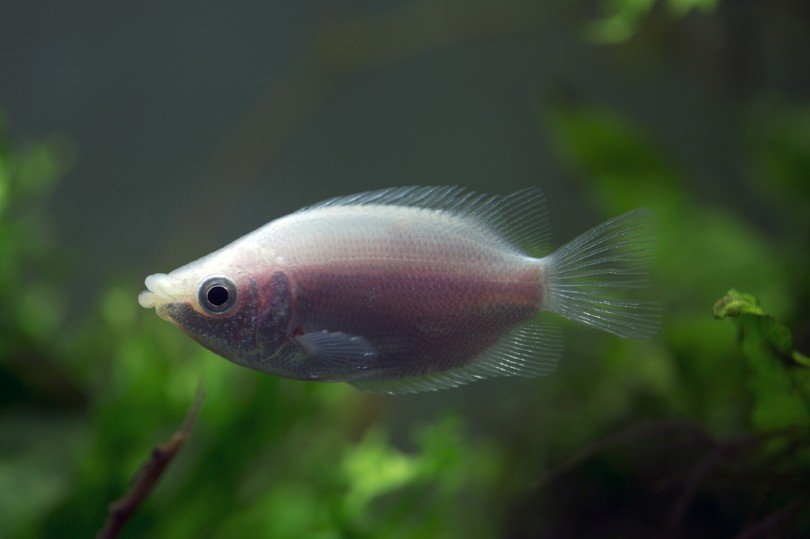
Kissing Gourami are easily recognizable by their out-turned lips, making them look like they are constantly trying to give someone a smooch. Sometimes they are seen “kissing” each other on the lips, but this is usually an aggressive display between males. They are available in shades of silvery pink and green and often feature speckles or spots. They can reach up to 12 inches in length and can live up to seven years or longer with proper care. Some Kissing Gourami have been reported to reach over 20 years old!
Kissing Gourami are considered semi-aggressive and may need to be separated from other fish if they begin showing bullying behaviors. They prefer tropical water temperatures but are pretty hardy to water parameters outside their preferred range. They should only be housed with fish that are approximately their size and that do not have similar body shapes to them, making Angelfish, Congo Tetras, Rosy and Tiger Barbs, and Clown Loaches good tankmate options. They require planted tanks with swimming space and a slow current.
2. Pearl Gourami
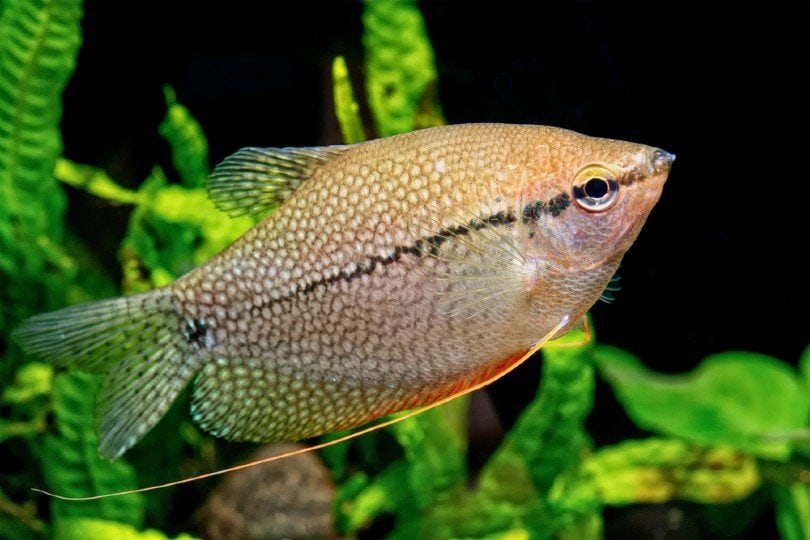
Pearl Gourami are smaller fish, only reaching around five inches in length. They can live for five years or more. They appear to be made from mother-of-pearl, which is where they get their name. Unlike many fish, they can vocalize, producing grunts, growls, and croaks.
Pearl Gourami are peaceful fish, although males may show aggression to another male Gourami. They make great tankmates to other similar-sized, peaceful fish, as well as smaller schooling fish. When keeping multiple Pearl Gourami, it’s best to keep only one male in the school. Pearl Gourami are bubble nest builders, so they may be seen near the water’s surface creating batches of floating bubbles. These fish need tropical water conditions but can tolerate a large range of water hardness.
3. Moonlight Gourami
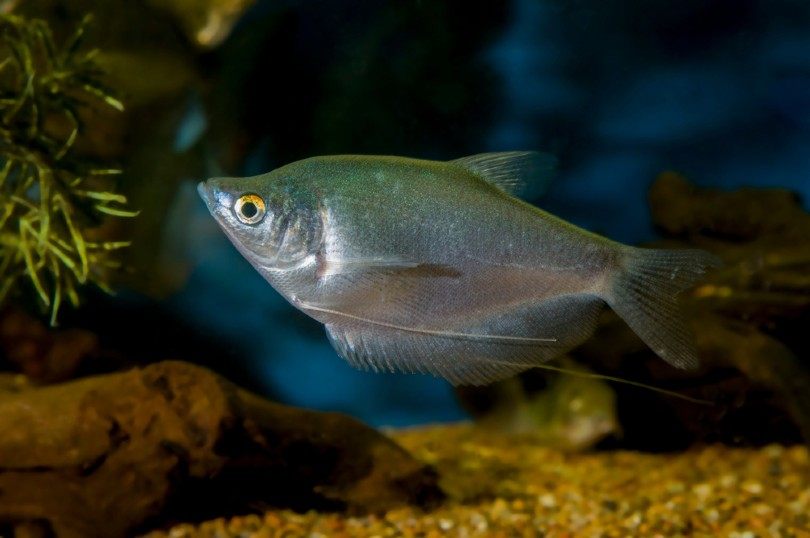
Moonlight Gourami get their name from their silvery-green, iridescent appearance that makes them look like shimmering moonlight. Males may be seen with orange or red coloration near their dorsal fin while females may have a yellowish hue.
Moonlight Gourami have orange or red coloration to the irises of their eyes. They are relatively peaceful fish but are best kept with similar-sized fish that will not nip fins. They may bully smaller fish, especially the males, in which case they will need to be separated. They are best kept in heavily planted, tropical tanks with a slow water current. They are hardy to a broad spectrum of water parameters.
4. Dwarf Gourami
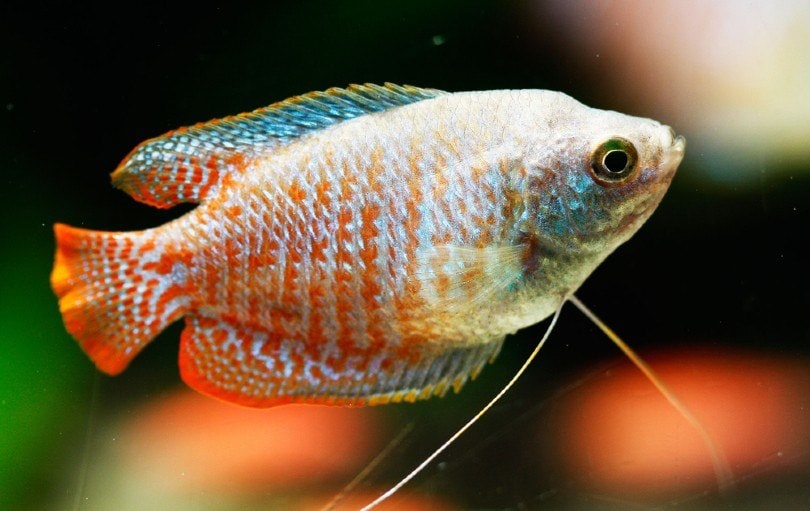
Dwarf Gourami are a beautiful Gourami variety, reaching up to just over four inches in length and able to live for five years or longer. These fish come in a rainbow of colors and can be neon, iridescent, or matte. They are hardy to rapid temperature fluctuations and poor water conditions.
Dwarf Gourami do best in planted tanks that include floating plants. They are peaceful fish but are not tolerant of fin nipping or bullying. They can be housed with other peaceful fish like Plecostomus, Mollies, and Loaches, as well as invertebrates like freshwater shrimps and snails.
5. Giant Gourami
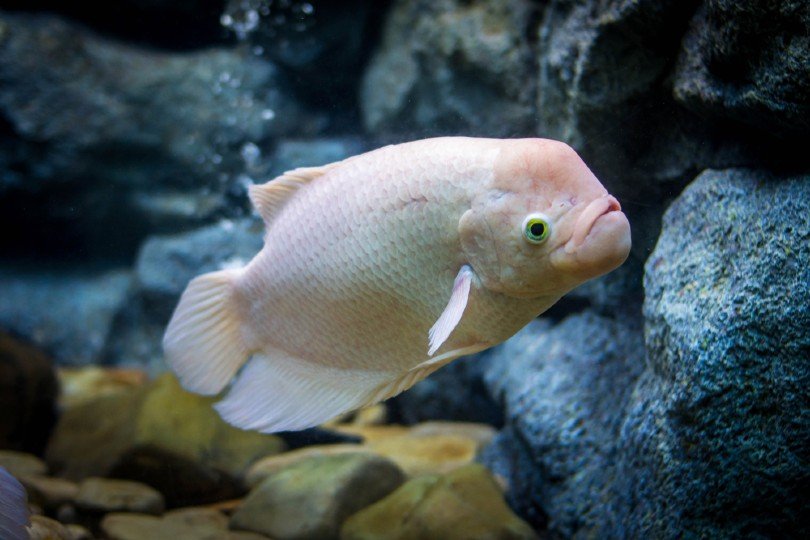
Giant Gourami are, as their name suggests, a very large variety of Gourami, able to reach lengths upwards of 16 inches. They require large tanks for adequate swimming space and appreciate a planted tank including floating plants. They are often seen in shades of white or silver, but there are Giant Gourami varieties available in other color combinations.
Giant Gourami are generally peaceful fish but are not naturally schooling fish, so they are content to be kept in a tank alone. These fish can recognize people and are so friendly that they may approach people and allow themselves to be petted. Like other Gourami, they are omnivores, but their size allows them to eat larger prey foods like earthworms and other fish. In the wild, these fish have been known to eat frogs and dead animals.
6. Chocolate Gourami

Chocolate Gourami are less hardy than some other Gourami varieties and require specialized care, making them somewhat difficult to keep. They prefer acidic water, usually with a pH between 4.0-6.0, and they require tropical temperatures. They are petite, only reaching three inches at the most, but can live to be eight years old.
Chocolate Gourami are named for their brown coloration, but they also feature three to five white or yellow stripes down the length of their body. They prefer humid environments, so keeping a tank hood on will help trap moisture and replicate this environment. They prefer planted tanks, but this may require supplementation to keep. Since they prefer acidic water, peat may be necessary to help remove minerals and nutrients from the water, which can make keeping plants difficult.
Chocolate Gourami prefer to school but often will not accept Gourami from outside their family group into their school. They are peaceful and slow-moving and can be housed with other peaceful fish like Danios, Loaches, and some varieties of Rasboras.
7. Blue Gourami/Three-Spot Gourami
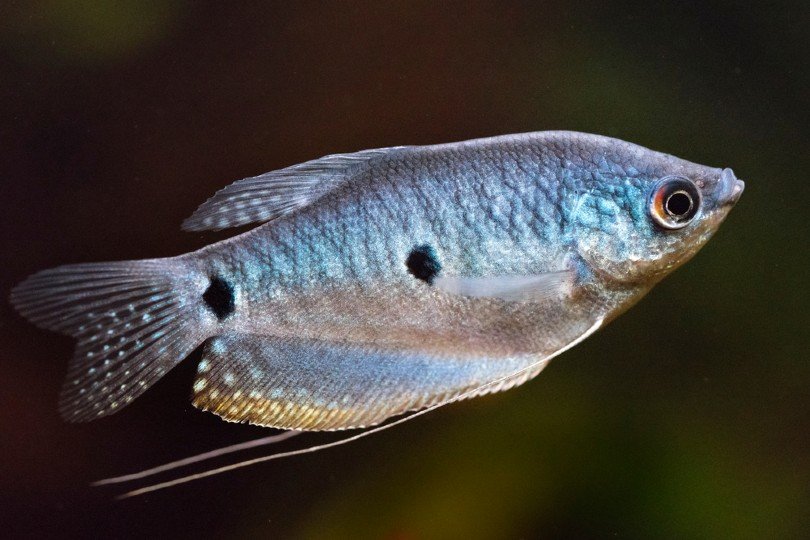
Blue Gourami prefer tropical water temperatures in planted tanks. They can reach up to five inches in length and live for five years or more. They are whitish-blue and have one spot in the middle of their body and one spot at the base of the tail. The third “spot” on Blue Gourami is their eye. Their colors may fade when they are stressed.
These fish are moderately aggressive and while they can be kept with other Blue Gourami, it’s best to avoid Dwarf Gourami, goldfish, and Angelfish. They can usually be safely kept with Loaches, Mollies, and Danios of similar size. Blue Gourami are omnivorous and one of their favorite foods is hydra, making them a great choice for controlling this pest in tanks.
8. Paradise Gourami

Paradise Gourami are around three inches in length and will live up to 10 years. They usually have orange or brownish bodies with blue and red stripes. These colors will brighten during the breeding season. They also have long fins and are a beautiful Gourami option. Unfortunately, many people choose them based on their looks without realizing they are aggressive tankmates.
Paradise Gourami mostly take their aggression out on other Gourami, but sometimes will attack other tankmates, and it isn’t out of the question for them to kill other fish. They are best housed with larger, peaceful fish like Comet or Common goldfish and certain Cichlid varieties. They can also be kept with large, peaceful fish that stay near the bottom of the tank, like Bristlenose Plecostomus and Clown Loaches. They prefer heavily planted tanks and tropical water temperatures.
9. Snakeskin Gourami
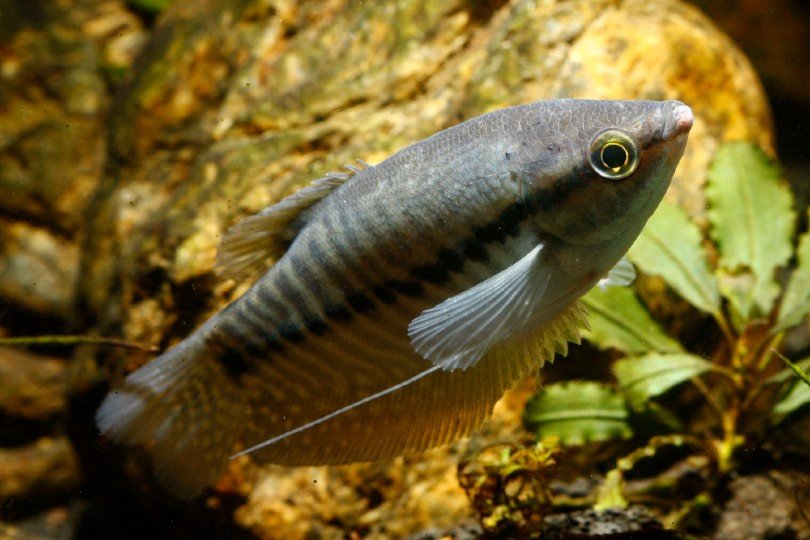
Snakeskin Gourami have a shimmery, snakeskin appearance, giving them their name. They can reach up to 10 inches in length and live for up to six years. They enjoy warm water but are hardy and can tolerate changes in water parameters. Like most Gourami, they like a planted tank with floating plants and plenty of space to swim.
Although large, they are peaceful fish and can be kept with Loaches, Barbs, and Corydoras. Keep in mind that although peaceful, these fish will eat live prey and should not be housed with fish they can eat. Overstocking the tank may also bring out some aggressive tendencies if the Snakeskin Gourami feels it must compete for food or space.
10. Sparkling Gourami/Pygmy Gourami
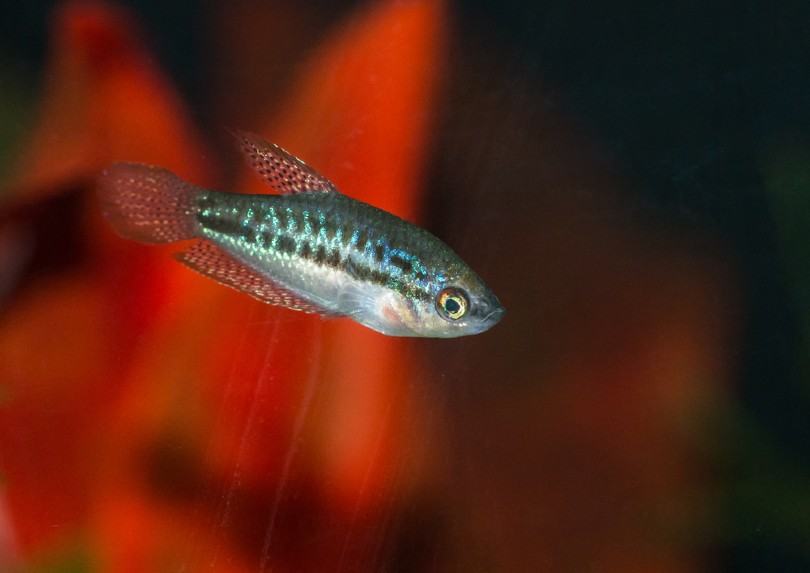
Sparkling Gourami are possibly the smallest variety of Gourami, usually not even reaching two inches in length. They live for up to five years and are relatively peaceful. They are colorful and glittery and marked with speckles and stripes, making them a beautiful addition to tanks. They are thinner and more streamlined than most Gourami, with a body resembling a Betta. Sparkling Gourami do not require large schools, but they do prefer to be housed with five or six other Sparkling Gourami.
Unlike most Gourami, this variety does not prefer to stay in the mid-level of the tank and can often be seen swimming all over. Like Pearl Gourami, Sparkling Gourami can vocalize, chirping and grunting when they are happy. They can tolerate water temperatures between 71-80˚F and prefer planted tanks with plenty of swimming space at all tank levels. They are best housed with slower, small tankmates that are not prone to nip fins, like Pearl Gourami, Dwarf Gourami, Tetras, and Corydoras.
11. Betta
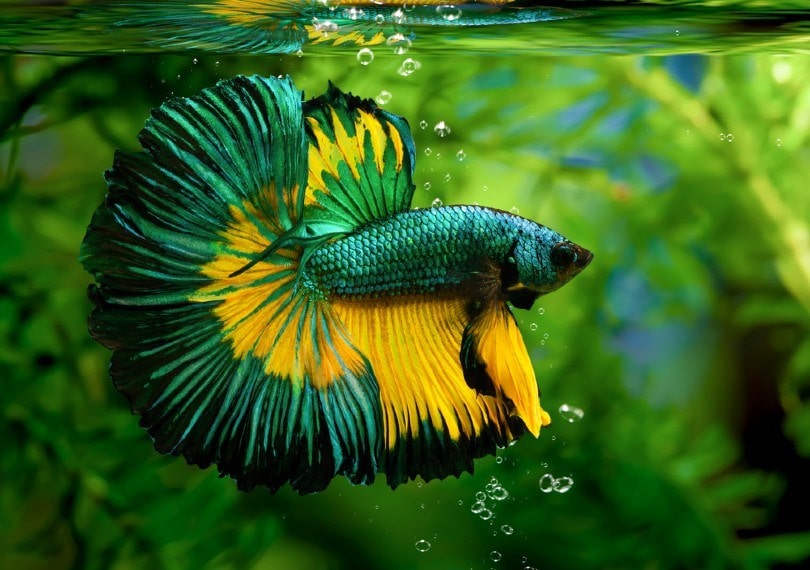
Betta fish are one of the most popular freshwater fish and many people do not realize they are a Gourami variety. They are less than three inches in length full-grown and can live for five years or more. They are hardy and tolerate poor water conditions with low oxygen. They come in dozens of color varieties and males have long, beautiful fins. The females have shorter, stubbier fins and are usually not as colorful.
Male Bettas can be aggressive and are best housed alone, but sometimes they can be kept in community tanks with peaceful fish that do not look like other Bettas. Female Bettas can be kept with male Bettas, but it’s best to ensure there are plants and lots of hiding places in case of male aggression. Aggressive male Bettas should be separated from other fish. Bettas are omnivores but have high protein needs and do not require dietary supplementation with vegetables.
12. Sunset Gourami/Honey Gourami

Sunset Gourami can reach up to three inches in length and live for eight years with good care. The females are usually a silver or greyish color while males are a honey-gold color with black markings. They are similar in appearance to Dwarf Gourami. These are a hardy Gourami variety, making them a nice choice for beginners, and they are peaceful. They prefer water temperature between 71-80˚F and plenty of plants and swimming space.
Sunset Gourami have a unique hunting mechanism where they will float at a diagonal angle from the water’s surface. If they see prey, they will squirt water at it to knock it into the water and then eat it. They are slow moving and enjoy being housed with a small group of Sunset Gourami. They can also be kept with peaceful fish like Corydoras and Danios.
13. Samurai Gourami
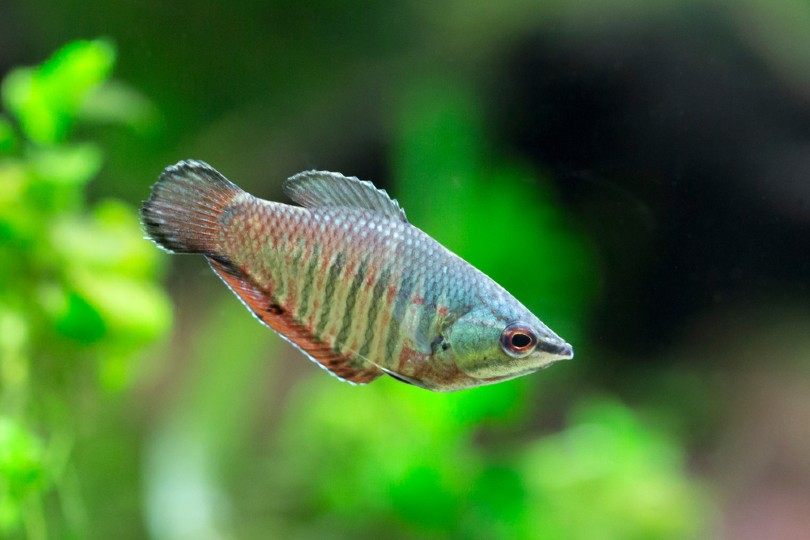
Samurai Gourami have similar care needs to Chocolate Gourami, preferring acidic water with low mineral and nutrient content. They are slightly hardier than Chocolate Gourami, though. Peat may be necessary to create this acidic environment and almond leaves can be added to the water to help create the blackwater environment they prefer. Samurai Gourami are unique in that the females are more colorful than the males. Males are usually brownish or grey while females usually have vertical red or green bars on the body. This is a peaceful Gourami variety, but the females tend to be more dominant than males. Samurai can reach up to 2 inches in length and live for up to 8 years. They are very shy and prefer a heavily planted tank with lots of hiding places. Caves and driftwood can help provide hiding places.
Samurai Gourami are one of few varieties of Gourami that are mouthbrooders, which means that after the female lays eggs, the male collects the eggs and holds them in his mouth until they are ready to hatch, anywhere from one to three weeks. He will not eat during this time. This variety of Gourami prefers live or frozen food but may eat freeze-dried food as well. They will often refuse to eat flakes or pellets.
14. Powder Blue Gourami

Powder Blue Gourami are a shy variety of Dwarf Gourami. They usually reach lengths close to 3 inches and can live to be 7 years old. As the name suggests, they are a beautiful shade of powder blue and are usually close to solid, lacking many markings that other Gourami have. They are hardy and a great choice for beginners. They prefer tropical, planted tanks with floating plants and should be housed in a quiet area as they can be stressed by loud or sudden noises. They can be housed with peaceful, slow-moving fish like Rasboras, Corydoras, some Loaches, small Rainbowfish, and Tetras.
15. Licorice Gourami
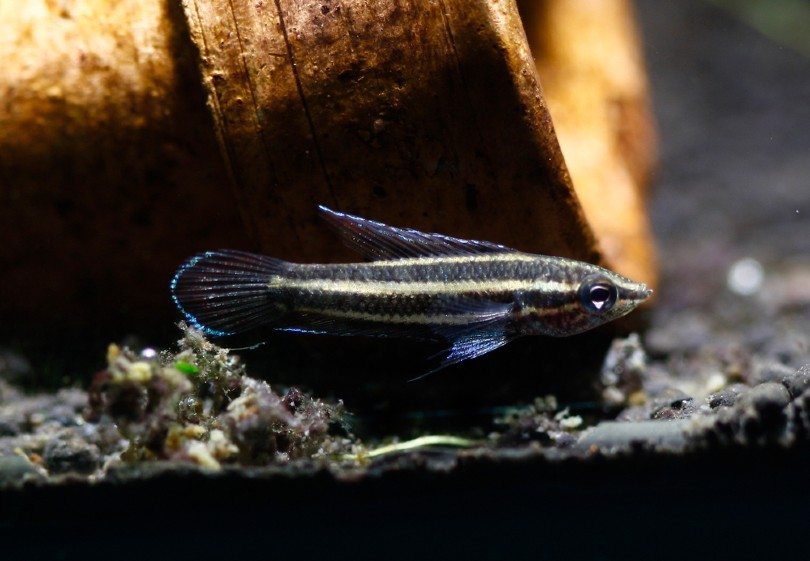
Licorice Gourami have a similar body shape to female Bettas. They typically reach lengths of two inches at the most. Males usually have long, black or silver stripes running vertically down the length of their body with red or blue coloration on the fins. Females are usually solid brown with black on the fins. Unlike most Gourami, this variety spawns in caves, so tanks should be complete with plenty of rock caves as well as plants. They appreciate their water temperature in the 71-78˚F range and will tolerate slow to moderate currents. They are peaceful but are often happiest in a species only tank. If kept with other tankmates, they should be small, slow-moving tankmates that will not bully the Licorice Gourami.
16. Gold Gourami
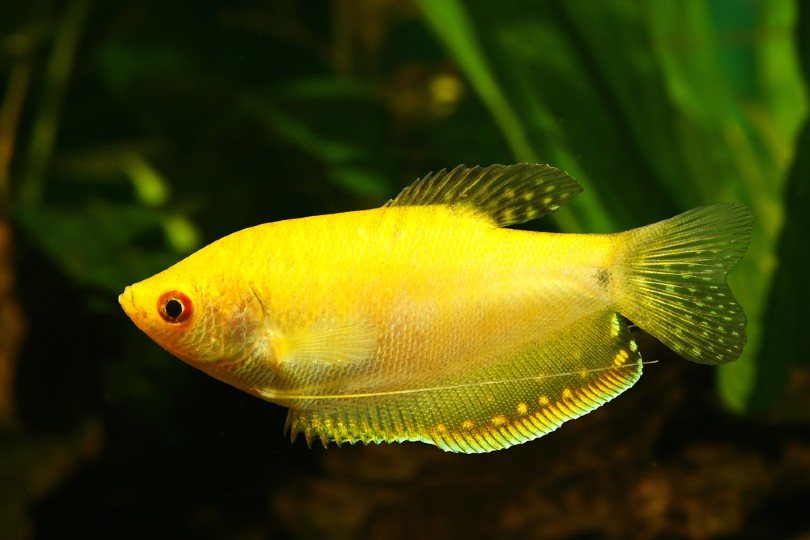
Gold Gourami are a color morph of the Blue Gourami, also called the Three-Spot Gourami. They are a gold color and tend to have few markings on the body. Their care needs are the same as Blue Gourami. They are up to five inches in length and can live upwards of five years. Like Blue Gourami, their colors may fade when they are stressed so care should be taken to provide a stress-free environment. They are moderately aggressive and should only be housed with peaceful fish of similar size like Loaches and Mollies.
17. Opaline Gourami
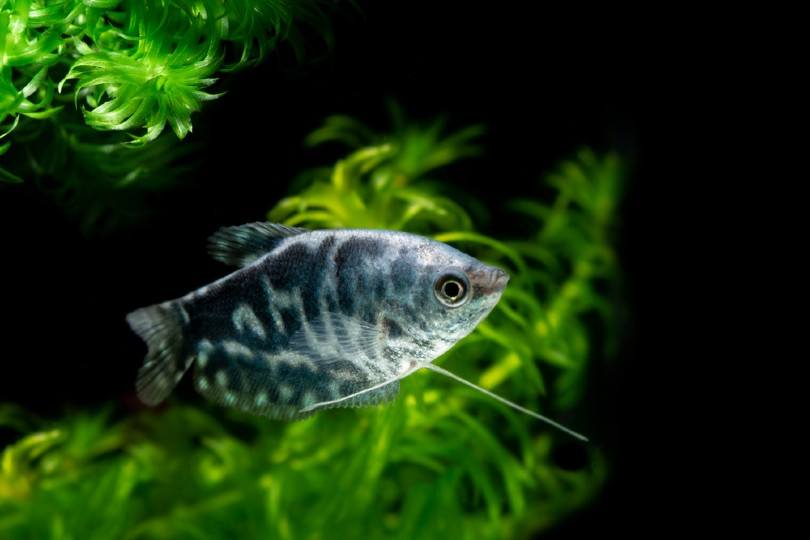
Opaline Gourami are another color morph of the Blue Gourami. Males and females are both a shade of light blue with darker blue marbling on the body. They often have dark areas near the back of the body. They can reach up to six inches in length and live for up to seven years. Their care is the same as that of Gold Gourami and Blue Gourami. Like both of those varieties, Opaline Gourami are moderately aggressive, especially the males. They can also increase in aggression as they age.
18. Thick-Lipped Gourami
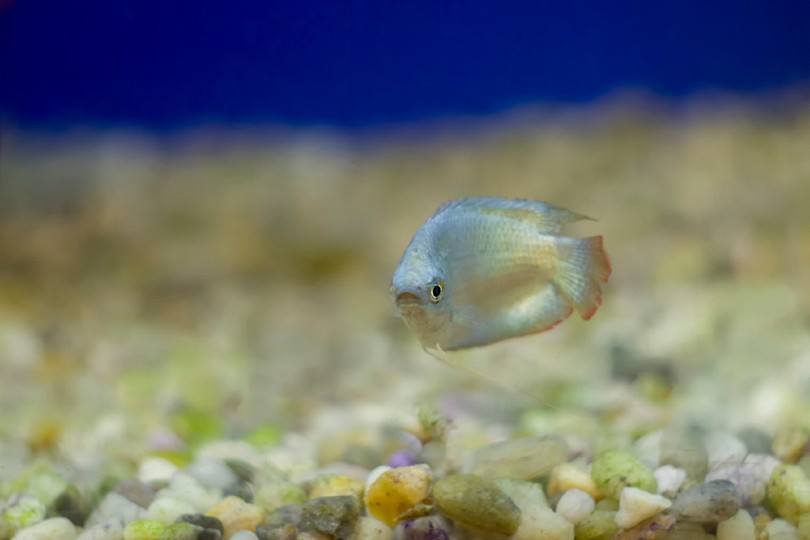
Thick-Lipped Gourami are a lesser-known variety of Gourami, but are hardy and peaceful, making them a great option for the beginner Gourami keeper. They can reach up to four inches in length and eight years of age. Thick-Lipped Gourami are usually a brown or gold color with turquoise or blue on the fins, making them one of the most colorful, beautiful Gourami varieties. They are closely related to Sunset Gourami. They prefer tropical planted tanks with floating plants and can be kept with other peaceful fish like Barbs, Loaches, and Rasboras.

Final Thoughts About Gourami
Gourami are fascinating fish and can be enjoyable to watch and interact with. They are not for the faint of heart, though. Some of them have complex care needs and aggression can become an issue with almost every variety of Gourami. They may need to be separated from their tankmates if they become aggressive.
These fish are unique and varied, so researching the perfect Gourami for the home aquarium can be fun and sometimes challenging. Gourami, like other fish, will need to be quarantined when first brought home and monitored for signs of disease. Once they are settled into their new home, their beautiful colors will shine through with proper care. Some of them might even reward you with happy chirps or the chance to give them a pat on the head!
Featured Image: Roberto Dani, Shutterstock



Không có nhận xét nào